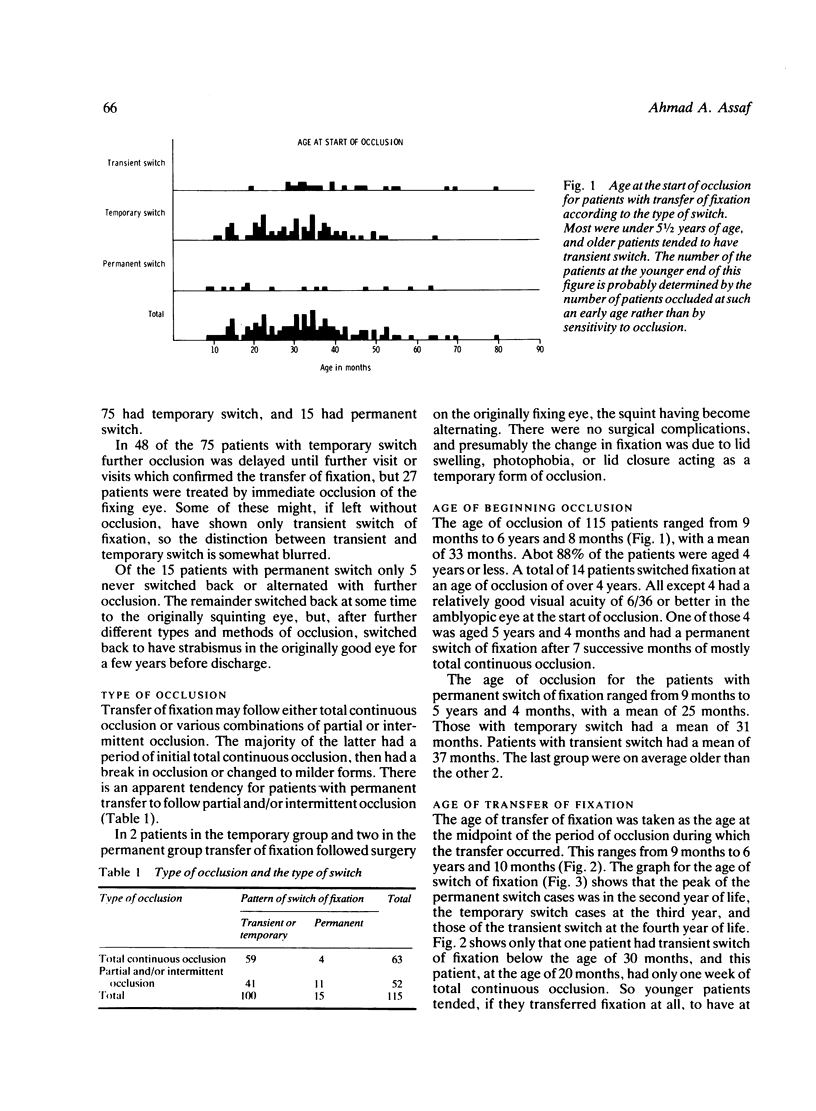Abstract
Of 2649 patients with strabismic amblyopia who attended clinics between 1941 and 1978, 1904 patients were reviewed. Of these, 115 patients had transfer of fixation after occlusion. These were analysed according to the type of transfer of fixation and relation to occlusion and age. The period of maximum sensitivity to short periods of occlusion extended to 18 months, declining to about 30 months of age. Sensitivity to occlusion reaches low levels about the age of 5 to 51/2 years, though it is still present to some degree, especially in patients with relatively good visual acuity of 6/36 or better. The upper limit of the sensitive period was found to be about the end of the seventh year of age.
Full text
PDF






Selected References
These references are in PubMed. This may not be the complete list of references from this article.
- Arden G. B., Barnard W. M. Effect of occlusion on the visual evoked response in amblyopia. Trans Ophthalmol Soc U K. 1979;99(3):419–426. [PubMed] [Google Scholar]
- Awaya S., Sugawara M., Miyake S. Observations in patients with occlusion amblyopia: results of treatment. Trans Ophthalmol Soc U K. 1979;99(3):447–454. [PubMed] [Google Scholar]
- Banks M. S., Aslin R. N., Letson R. D. Sensitive period for the development of human binocular vision. Science. 1975 Nov 14;190(4215):675–677. doi: 10.1126/science.1188363. [DOI] [PubMed] [Google Scholar]
- Crawford M. L., Blake R., Cool S. J., von Noorden G. K. Physiological consequences of unilateral and bilateral eye closure in macaque monkeys: some further observations. Brain Res. 1975 Jan 24;84(1):150–154. doi: 10.1016/0006-8993(75)90809-4. [DOI] [PubMed] [Google Scholar]
- Dobson V., Teller D. Y. Visual acuity in human infants: a review and comparison of behavioral and electrophysiological studies. Vision Res. 1978;18(11):1469–1483. doi: 10.1016/0042-6989(78)90001-9. [DOI] [PubMed] [Google Scholar]
- HARDESTY H. H. Occlusion amblyopia; report of a case. AMA Arch Ophthalmol. 1959 Aug;62(2):314–316. doi: 10.1001/archopht.1959.04220020140020. [DOI] [PubMed] [Google Scholar]
- Hohmann A., Creutzfeldt O. D. Squint and the development of binocularity in humans. Nature. 1975 Apr 17;254(5501):613–614. doi: 10.1038/254613a0. [DOI] [PubMed] [Google Scholar]
- Hubel D. H., Wiesel T. N. The period of susceptibility to the physiological effects of unilateral eye closure in kittens. J Physiol. 1970 Feb;206(2):419–436. doi: 10.1113/jphysiol.1970.sp009022. [DOI] [PMC free article] [PubMed] [Google Scholar]
- LEINFELDER P. J. Amblyopia associated with cogenital cataract. Am J Ophthalmol. 1963 Mar;55:527–529. [PubMed] [Google Scholar]
- Linksz A. Visual acuity in the newborn with notes on some objective methods to determine visual acuity. Doc Ophthalmol. 1973 Feb 21;34(1):259–270. doi: 10.1007/BF00151813. [DOI] [PubMed] [Google Scholar]
- Singh G., Das P. N. Pattern of amblyopia and fixation after keratoplasty. Br J Ophthalmol. 1978 Jan;62(1):29–33. doi: 10.1136/bjo.62.1.29. [DOI] [PMC free article] [PubMed] [Google Scholar]
- Sokol S., Jones K. Implicit time of pattern evoked potentials in infants: an index of maturation of spatial vision. Vision Res. 1979;19(7):747–755. doi: 10.1016/0042-6989(79)90150-0. [DOI] [PubMed] [Google Scholar]
- Taylor D., Vaegan, Morris J. A., Rodgers J. E., Warland J. Amblyopia in bilateral infantile and juvenile cataract. Relationship to timing of treatment. Trans Ophthalmol Soc U K. 1979 Apr;99(1):170–175. [PubMed] [Google Scholar]
- Vaegan, Taylor D. Critical period for deprivation amblyopia in children. Trans Ophthalmol Soc U K. 1979;99(3):432–439. [PubMed] [Google Scholar]
- Von Noorden G. K., Dowling J. E., Ferguson D. C. Experimental amblyopia in monkeys. I. Behavioral studies of stimulus deprivation amblyopia. Arch Ophthalmol. 1970 Aug;84(2):206–214. doi: 10.1001/archopht.1970.00990040208014. [DOI] [PubMed] [Google Scholar]
- Von Noorden G. K. Factors involved in the production of amblyopia. Br J Ophthalmol. 1974 Mar;58(3):158–164. doi: 10.1136/bjo.58.3.158. [DOI] [PMC free article] [PubMed] [Google Scholar]
- Von Noorden G. K., Maumenee E. Clinical observations on stimulus-deprivation amblyopia (amblyopia ex anopsia). Am J Ophthalmol. 1968 Feb;65(2):220–224. doi: 10.1016/0002-9394(68)93590-3. [DOI] [PubMed] [Google Scholar]
- Wilkinson F. E. Reversal of the behavioural effects of monocular deprivation as a function of age in the kitten. Behav Brain Res. 1980 Feb;1(1):101–123. doi: 10.1016/0166-4328(80)90048-0. [DOI] [PubMed] [Google Scholar]
- von Noorden G. K., Crawford M. L. Morphological and physiological changes in the monkey visual system after short-term lid suture. Invest Ophthalmol Vis Sci. 1978 Aug;17(8):762–768. [PubMed] [Google Scholar]
- von Noorden G. K., Crawford M. L. The sensitive period. Trans Ophthalmol Soc U K. 1979;99(3):442–446. [PubMed] [Google Scholar]
- von Noorden G. K. Experimental amblyopia in monkeys. Further behavioral observations and clinical correlations. Invest Ophthalmol. 1973 Oct;12(10):721–726. [PubMed] [Google Scholar]
- von Noorden G. K. Histological studies of the visual system in monkeys with experimental amblyopia. Invest Ophthalmol. 1973 Oct;12(10):727–738. [PubMed] [Google Scholar]


